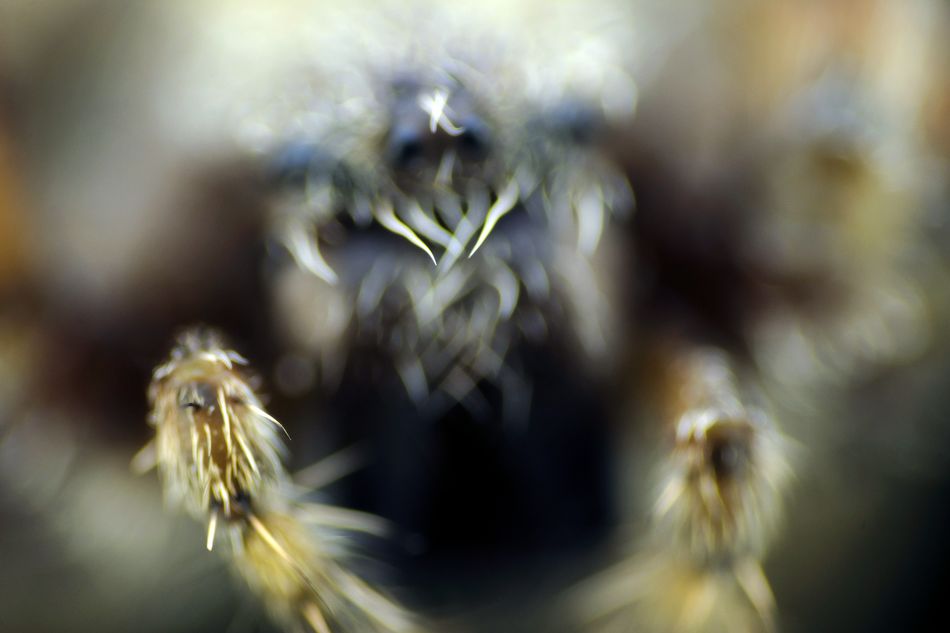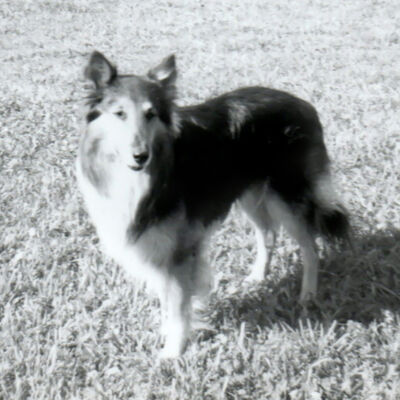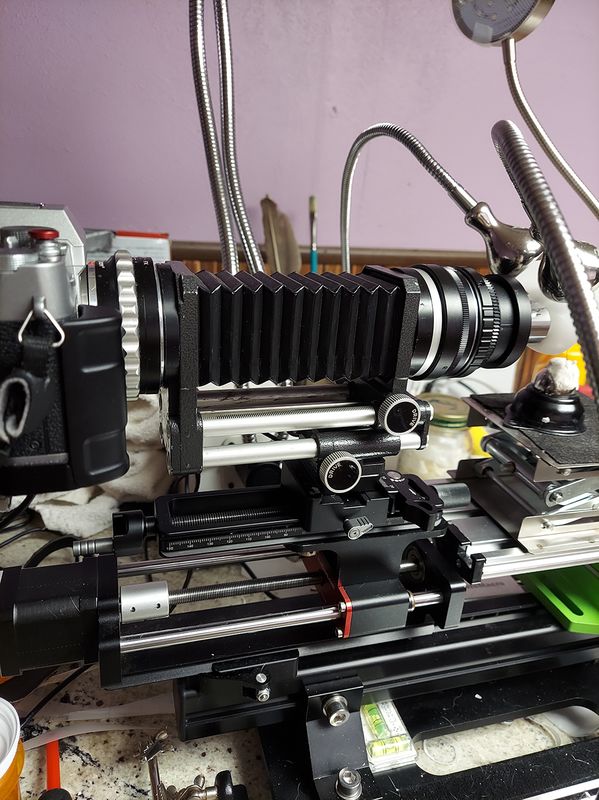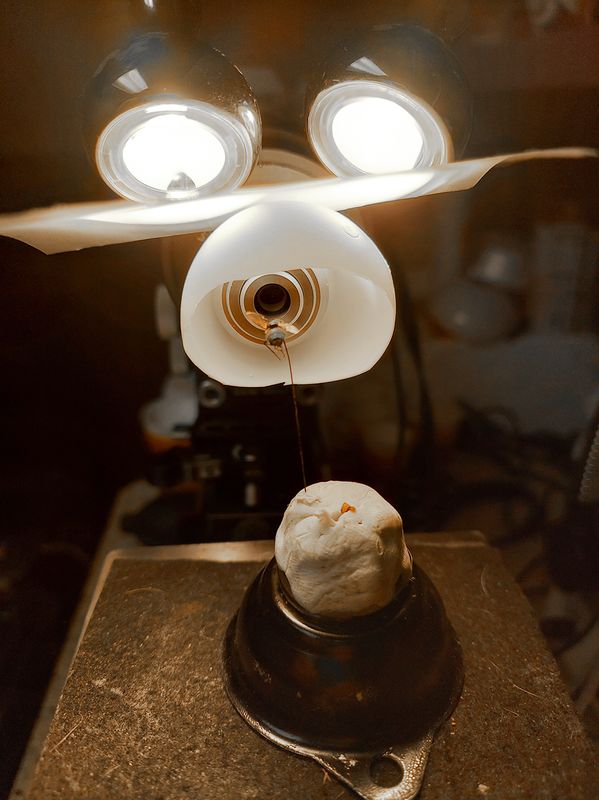Focus Stacked Image of a Weevil
Oct 23, 2021 23:31:36 #
sscnxy wrote:
Hi Sippyjug. Thanks for teaching us the technical... (show quote)
SSCNXY, thanks for asking about what I do and how I do it for I truly enjoy sharing it.
I find the closest and the farthest points of the subject, like the tip of a close hair as the closest and the back ridge of the top of its head for example as the farthest points of where my images will start and stop. I use a mirrorless camera and I watch the "blinkies" as I advance the camera from the closest point while I move it toward the farthest (endpoint for the series of shots). The attached photo shows what the starting point looks like where only the tip of the hair on the closest spider's leg is in focus.
The depth of field (DOF) is best found by the technical info of the lens....if we are lucky enough to find it and when using extensions such as a helicoid, extension tube, or bellows that info is no longer valid. Now, reversing the lens adds even more "off the published chart".
So.....to measure the resultant DOF we need to know two things. The f/stop and the amount of magnification we have accomplished with our rig is easy to measure using a scale marked in millimeters and viewing how many we see through the lens and then by knowing the size of our sensor be it full or crop.
See my past post on how to measure the amount of magnification you are getting with your setup. https://www.uglyhedgehog.com/t-679798-1.html
The formula DOF = (0.0022*N*N*(m+1)*(m+1))/(m*m) , where N is the F-number and m is magnification. For example: f/stop-number 5.6 and magnification 0.50 computes as:
DOF = (0.0022*5.6*5.6*(0.50+1)*(0.50+1))/(0.50*0.50) = 0.6209 millimeters
So...in that case, we know where the first shot is taken and how far the camera must move to get to the last shot so we divide that travel distance by the DOF, and THAT gives us the number of shots to be taken at every 0.6209 millimeters that the camera moves forward in this example.
IF...you were to buy a dedicated focus stacking software...I STRONGLY recommend Zerene Stacker for the reason that it is created by Rick Littlefield who lives in the U.S. and he lives and breathes macro photography and he makes himself available to answer any questions and solve any problems you may have in addition to him giving advice as a mentor. Helicon Focus is highly comparable however it is written off-shore and there is no person-to-person support or mentoring. It is very good and well-liked by many. I just like to have the "local feel" and to be able to speak to the fellow that created the program who knows it best.
By the way, I've done stacks that were well over 1,000 images and I racked up over 250,000 shots on my Nikon D810 before switching over to a little mirrorless Fujifilm with an electronic shutter so as not to wear it out.
Oct 24, 2021 09:31:06 #
sippyjug104 wrote:
This is one of my preserved flower-eating weevils of which one is brown and this one is black. I have them preserved in denatured alcohol and I brought this one out for inspection and staged it for a focus stacking session.
I staged this session with a reversed mounted 50mm f/2.8 enlarger lens attached to a bellows which was extended to a length that brought the entire specimen to fill the frame of the APS-C sensor camera for 414 images and processed in Zerene Stacker.
I staged this session with a reversed mounted 50mm f/2.8 enlarger lens attached to a bellows which was extended to a length that brought the entire specimen to fill the frame of the APS-C sensor camera for 414 images and processed in Zerene Stacker.
that is beautiful work, sippy!!


Oct 24, 2021 09:42:23 #
sippyjug104 wrote:
Thanks, BigDaddy. The process starts with the dep... (show quote)
Thanks for that excellent explanation. Way past my experience with exposure bracketing🤷♀️ Amazing that you/camera can control all that to that degree.
The photo is amazing and knowing what is involved makes it even more amazing. Thanks again.
Oct 24, 2021 11:58:02 #
merrytexan wrote:
that is beautiful work, sippy!! 



Merrytexan, thanks ever so much for viewing and for the reply.
Oct 24, 2021 12:07:42 #
BigDaddy wrote:
Thanks for that excellent explanation. Way past my experience with exposure bracketing🤷♀️ Amazing that you/camera can control all that to that degree.
The photo is amazing and knowing what is involved makes it even more amazing. Thanks again.
The photo is amazing and knowing what is involved makes it even more amazing. Thanks again.
Thanks, BigDaddy. I use a motorized digital focus rail that allows me to set the distance of each stop down to that of microns. It also controls the shutter so that once I click the button on the PC the process is fully automated. My 'goto' lenses for my sessions are typically microscope objectives for they are optically flat depth of field and I know exactly what the magnification will be.
This is the setup that I use when I do 10X-magnification sessions. I use a ping-pong ball with a bit of tracing paper over it to diffuse the light. You can see the green bottle fly staged in front of the 10X microscope objective to give you an idea of how close the subject is to the end of the objective.
Oct 24, 2021 13:06:28 #
sippyjug104 wrote:
Thanks, BigDaddy. I use a motorized digital focus... (show quote)
Wow, totally amazing. I'm at a loss for words, and that probably is a good thing...
Very, very impressive is all I can say.
Microns are small, I have a hard time focusing on trees and buildings...
Oct 25, 2021 04:56:54 #
sippyjug104 wrote:
SSCNXY, thanks for asking about what I do and how ... (show quote)
Hi Sippyjug. You absolutely da bestest, a special mentor to us all. I appreciate your detailed instructions very, very much.
NY
Oct 25, 2021 12:03:48 #
sippyjug104 wrote:
This is one of my preserved flower-eating weevils of which one is brown and this one is black. I have them preserved in denatured alcohol and I brought this one out for inspection and staged it for a focus stacking session.
I staged this session with a reversed mounted 50mm f/2.8 enlarger lens attached to a bellows which was extended to a length that brought the entire specimen to fill the frame of the APS-C sensor camera for 414 images and processed in Zerene Stacker.
I staged this session with a reversed mounted 50mm f/2.8 enlarger lens attached to a bellows which was extended to a length that brought the entire specimen to fill the frame of the APS-C sensor camera for 414 images and processed in Zerene Stacker.
Lotsa work=great image! Again wonderful job! Thanx for sharing!
Oct 26, 2021 15:44:50 #
Oct 26, 2021 15:46:11 #
sippyjug104 wrote:
Thanks, BigDaddy. I use a motorized digital focus... (show quote)
That is really cool.
If you want to reply, then register here. Registration is free and your account is created instantly, so you can post right away.







